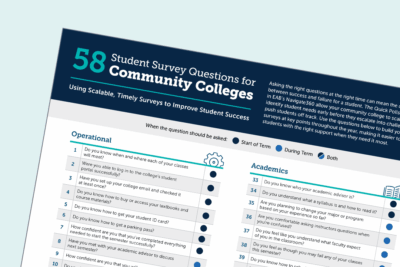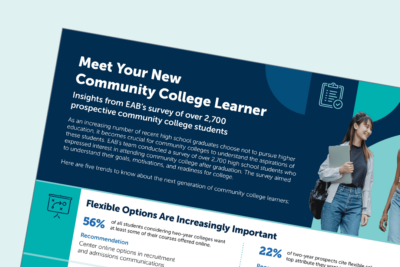Community College Students’ Expectations for Service Have Risen Since the Pandemic
Administrators agree that enrollment and retention challenges are exacerbated by poor customer service
June 26, 2023Washington, DC (June 26, 2023) — According to a national survey of community college leaders released today by education company EAB, 85 percent of respondents say students’ expectations for “customer service” have risen since the pandemic. Ninety-nine percent of respondents agree better customer service is essential to student retention, which creates an urgent need for institutions to become more service-oriented and responsive to students’ concerns and questions.
“There are nearly one million fewer students attending community colleges today than there were pre-pandemic, and the vast majority of community college leaders recognize that poor customer service is at least partially to blame,” said Tara Zirkel, EdD, Director of Strategic Research at EAB. “The problem is that schools were already falling short in this area while student expectations for how they want to be treated as consumers were growing, so schools have a lot of catching up to do.”
Prior research shows that customer service is not an area where community colleges have excelled historically, and the gap in customer service has only widened in recent years. Community college leadership, staff, and faculty acknowledge that customer service weaknesses, such as those listed below, create confusion and unnecessary roadblocks, which contribute to enrollment and retention challenges:
- 81 percent of survey respondents say confusing onboarding steps cause new or prospective students to opt out before class even begins.
- 84 percent say current students have trouble reaching enrollment staff at least some of the time, and 63 percent believe that trouble connecting with the enrollment office often causes students to stop out.
- 62 percent recognize that students must take time away from their families and jobs to resolve college issues.
“Community colleges tend to attract students who are the first in their families to attend college and older students who are working or raising families,” Dr. Zirkel continued. “When a student encounters a confusing or difficult process, and that student lacks a strong support network or is juggling work and parenting responsibilities, they are more likely to turn away from college altogether.”
To improve the student experience, EAB urges schools to make both process and technology upgrades that simplify the registration process and streamline other administrative obstacles. For example, institutions can benefit by adopting a customer relationship management platform designed specifically for higher education that helps students navigate their college journey. EAB’s report includes the following additional recommendations:
- Invest in customer service professional development and training for administrators.
- Audit processes to identify both technology and workflow bottlenecks.
- Check in with students about their college experience.
- Use technology to automate manual processes and help students get answers faster.
- Use data insights to proactively anticipate and meet students’ needs.
EAB’s national Community College Student Customer Service Survey was completed by 164 community college administrators and faculty. More than half are at the dean or director level. The full survey results and recommendations are available at https://pages.eab.com/Modern-Student-Experience-Survey-Insight-Paper.html.
About EAB
At EAB, our mission is to make education smarter and our communities stronger. We work with more than 2,500 institutions to drive transformative change through data-driven insights and best-in-class capabilities. From kindergarten to college to career, EAB partners with leaders and practitioners to accelerate progress and drive results across enrollment, student success, institutional strategy, and data analytics. We work with each partner differently, tailoring our portfolio of research, technology, and marketing and enrollment solutions to meet the unique needs of every leadership team, as well as the students and employees they serve. Learn more at eab.com.
More Resources

58 student survey questions for community colleges

Meet your new community college learner
